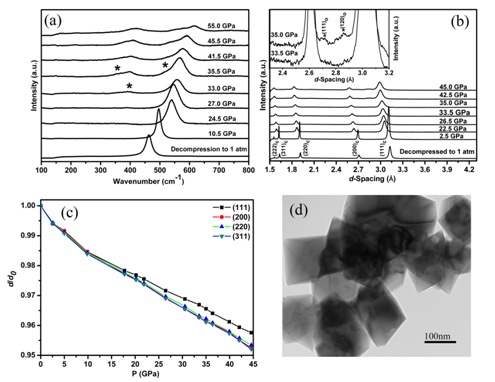| High-Pressure Studies on CeO2 Nano-Octahedrons with a (111)-Terminated Surface |
| From: PublishDate:2012-03-15 Hits: |
High-pressure studies on nanostructured material have attracted great enthusiasm because of the appearance of many novel high-pressure behaviors in the nanomaterials. The phase transition pressure and process of nanomaterials strongly depend on their grain size, shape, and structure. However,previous studies have been focused on the size effect which has a strong influence on the critical pressures for phase transitions, phase transition routines, and even amorphization processes. Thus, it requires an in-depth exploration on the high-pressure phase transition and the phase transition mechanism of nanomaterials with special morphologies. Bingbing Liu and her co-workers from State Key Laboratory of Superhard Materials Jilin University have pay insight into high-pressure studies of CeO2 nanomaterials with special exposure surface by in situ high-pressure synchrotron X-ray diffraction. Their research has been published on March3th, 2011 in the Journal of Physical Chemistry C.
Figure 1. (a)In-situ high-pressure Raman spectrum of samples, (b) In-situ high-pressure synchrotron X-ray diffraction spectrum of samples, (c) Variation of relative d spacing (d/d0) for the CeO2 nanooctahedrons and (d) TEM image of CeO2 nano-octahedrons released from 55 GPa to ambient condition The team have been performed In situ high-pressure X-ray diffraction and Raman spectroscopy on well-shaped CeO2 nano-octahedrons enclosed by eight (111) planes. High-pressure X-ray diffraction experiments were carried out using a synchrotron X-ray source (λ = 0.6199 Å) of the 4W2 High-Pressure Station of Beijing Synchrotron Radiation Facility (BSRF). A phase transition from an initial fluorite-type structure to a α-PbCl2 phase in CeO2 nano-octahedrons has been observed at above 33 GPa. The transition pressure is slightly higher than that for bulk CeO2 (at 31 GPa) and much higher than that for 12 nm CeO2 nanocrystals (at 23-27 GPa). Furthermore, such transformation is complete at 38 GPa for both bulk and 12 nm CeO2 nanoparticles but far from completion for CeO2 nano-octahedrons even at 55 GPa. The TEM image on the sample after decompression from 55 GPa clearly shows that the nano-octahedrons preserve the starting shape. Such distinct high-pressure behavior in CeO2 nano-octahedrons is believed to be due to their intrinsic geometry. Further analysis shows that the lower compressibility of the exposed (111) planes in the CeO2 nano-octahedrons may be the critical factor to elevation of the phase transition pressure and the sluggishness of the transition. Indeed, the characteristics of synchrotron radiation at BSRF such as more brilliant synchrotron beams and smaller synchrotron spots would surely help to obtain strong diffraction lines of sample avoiding the interferences beyond sample chamber. This research has used the exposure (111) planes as a detector to explore high-pressure phase transition behaviors of CeO2 nano-octahedrons. This work exhibited the special morphologies played an important role on the high pressure behaviors of nanomaterials. Article: High-Pressure Studies on CeO2 Nano-Octahedrons with a (111)-Terminated Surface J. Phys. Chem. C. (115)20114546–4551. Bo Liu, Mingguang Yao, Bingbing Liu,* Zepeng Li, Ran Liu, Quanjun Li, Dongmei Li, Bo Zou, Tian Cui, and Guangtian Zou State Key Laboratory of Superhard Materials, Jilin University, Changchun 130012, P. R. China Jing Liu Institute of High Energy physics, Chinese Academy of Sciences, Beijing 100023, P. R. China Zhiqiang Chen GeoScience Department, Stony Brook University, Stony Brook, New York 11794, United States *Correspondence: liubb@jlu.edu.cn Acknowledgment: This work was supported financially by the NSFC (10979001, 51025206), the National Basic Research Program of China (2011CB808200), the Cheung Kong Scholars Programme of China. This work was performed at 4W2 beamline, Beijing Synchrotron Radiation Facility (BSRF), which is supported by the Chinese Academy of Sciences (grant no. KJCX2-SW-N20, KJCX2-SW-N03). |
|
|
| Chinese
Science Highlights
Home /
Copyright © 2011 - 2012 Beijing Synchrotron Radiation Facility


